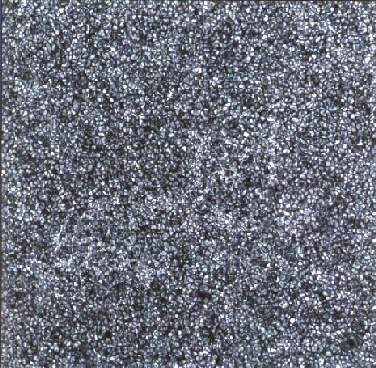The Solar Photosphere
A poster of solar granulation
This poster represents the most detailed and clear image ever made of the solar surface. It shows only a tiny portion of the surface of the Sun, taken in a narrow band of the visible spectrum. It is one of a series of posters that illustrate the beauty and complexity of the star that provides the energy to sustain life on Earth.
The image shows a 121,000 km square region at the center of the Sun's disk. The Sun has a diameter of 1,400,400 km so that this picture covers only about 1% of the disk. To display the entire Sun at the same scale would require a poster 7 meters (23 feet) square. About 100 images of the Earth could be placed in the area shown in the poster.
The solar surface consists mostly of an irregular cellular pattern caused by the temperature variations in the surface. The cells, called granules, are evidence of convection, the mechanism that transports heat to the surface. Each of the cells is about the size of Texas. Convection is the technical term for heat transport by overturning fluid or gas. We can observe convection in daily life: boiling is an example of transporting energy by convection, as are the thermal plumes that form thunderstorms.
This image only captures an instant in time. The surface of the Sun, like the surface of a pot of boiling water, is constantly changing. A picture taken 10 minutes later would look very similar, but it would be hard to recognize any granules common to both images. This occurs because granules only survive for about 5 minutes. A typical granule delivers as much energy in 5 minutes as a giant hydro-electric power station like that at Hoover dam does in 1,000 years!
This image was taken through a special filter that selects light that is partially absorbed by the Carbon-Hydrogen radical CH, which is especially sensitive to temperature changes int he solar atmosphere near the surface. The tiny bright points seen throughout the image are sites of magnetic field. These sites have a magnetic field strength about a thousand times greater than the Earth's field. On this image they appear as tiny dots; nevertheless they are about 150 km in diameter -- bigger than London, Tokyo, or Los Angeles. So although they appear tiny on the scale of the Sun, a great deal may be going on inside them. Scientists believe that the tiny sites of magnetic field are the channels which transport energy to heat the outer atmosphere of the Sun to temperatures of millions of degrees. They are the connections to the solar surface of the huge structures seen about the surface in the solar corona in X-rays and over the solar limb during eclipses.
This image was taken by Professor Goran Scharmer with the Swedish Vacuum Solar Telescope (SVST) of the Royal Swedish Academy of Sciences. The SVST is one of a number of telescopes at the Roque de Los Muchachos site of the Instituto de Astrofisica de Canarias on the island of La Palma, Canary Islands, owned by Spain. The telescope is a 50 cm refractor with an altitude-azimuth system of mirrors that sends light down a vacuum-sealed tube to an observing room with an array of scientific instruments. The picture was taken using a movable image-stabilization mirror that constantly adjusted the position of the Sun on the image plane. The stabilization system removes image motion introduced by wind and turbulence in the Earth's atmosphere.A 1.2 nanometer CH filter produced by Andover Corporation isolates the CH region of the spectrum around 430.5 nanometers. The detector was a 2048x2048 CCD array in a Kodak Megaplus(tm) 4.2 camera. The camera takes 14 millisecond exposures three times a second.The constant stream of images is sent to a Digital Equipment Corporation Alpha(tm) 9000 Workstation that computes the quality of each image in real-time. Every 20 seconds the best image in that interval is selected and saved on disk and its time and quality recorded. This image is outstanding because it is sharp over the entire picture: normally images are blurred by distortions introduced by the Earth's atmosphere and these distortions usually have the size of only a few granules. An image that is as good as this one over a field 100 granules wide is captured only once in about a million exposures.
Poster produced by Lockheed Martin Palo Alto Research Laboratory.
For more information contact: Professor Goran Scharmer, RSAC or Zoe Frank, LMATC.
Back to Hidden Pictures activity

https://solar-center.stanford.edu/hidden-pic/poster.html
Copyright © 1997 Lockheed Martin Palo Alto Research Laboratory All rights reserved.

 SOLAR Center Home
Page
SOLAR Center Home
Page
 Comments?
Comments?